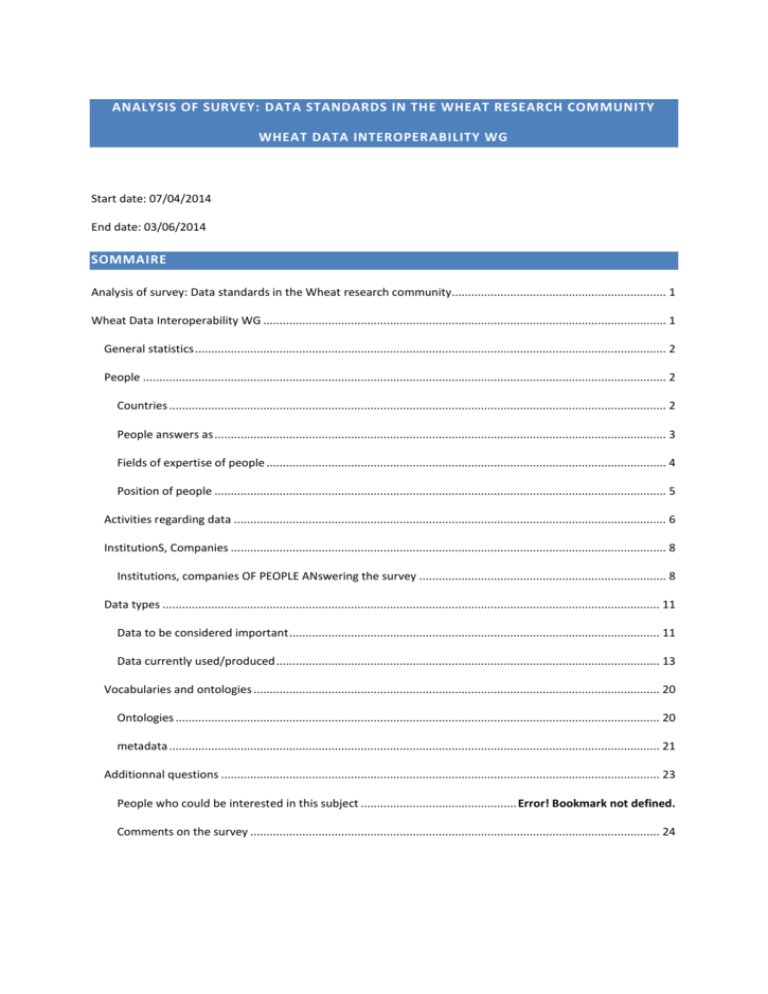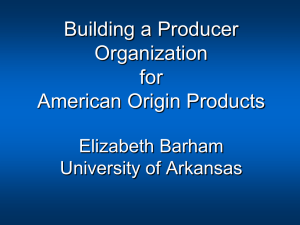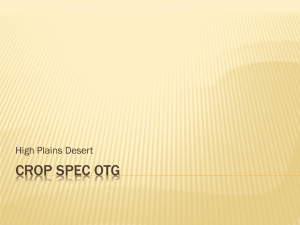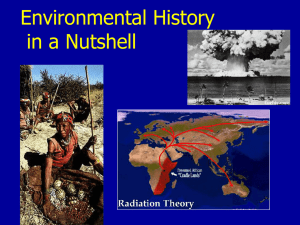RDA_survey_analysis-2
advertisement

ANALYSIS OF SURVEY: DATA STANDARDS IN THE WHEAT RESEARCH COMMUNITY WHEAT DATA INTEROPERABILITY WG Start date: 07/04/2014 End date: 03/06/2014 SOMMAIRE Analysis of survey: Data standards in the Wheat research community.................................................................. 1 Wheat Data Interoperability WG ............................................................................................................................ 1 General statistics ................................................................................................................................................. 2 People ................................................................................................................................................................. 2 Countries ......................................................................................................................................................... 2 People answers as ........................................................................................................................................... 3 Fields of expertise of people ........................................................................................................................... 4 Position of people ........................................................................................................................................... 5 Activities regarding data ..................................................................................................................................... 6 InstitutionS, Companies ...................................................................................................................................... 8 Institutions, companies OF PEOPLE ANswering the survey ............................................................................ 8 Data types ......................................................................................................................................................... 11 Data to be considered important .................................................................................................................. 11 Data currently used/produced ...................................................................................................................... 13 Vocabularies and ontologies ............................................................................................................................. 20 Ontologies ..................................................................................................................................................... 20 metadata ....................................................................................................................................................... 21 Additionnal questions ....................................................................................................................................... 23 People who could be interested in this subject ................................................ Error! Bookmark not defined. Comments on the survey .............................................................................................................................. 24 GENERAL STATISTICS Total number of answers: 201 Number of complete answers: 125 Total number of incomplete answers: 77 (6 doubles removed: people who answered twice) Number of answers considered: 196 All answers, i.e. complete and incomplete, are taken into account in the following as questions were not mandatory. PEOPLE COUNTRIES Country 1% 27% 2% 3% 4% 12% 5% 7% 7% 11% No answer (53) United States of America (24) Australia (22) France (14) United Kingdom (14) Italy (10) India (7) Germany (5) Japan (5) Canada (4) Mexico (4) Pakistan (4) Czech Republic (3) Turkey (3) Argentina (2) Egypt (2) Ireland (2) Nepal (2) Tunisia (2) Uruguay (2) Brazil (1) Croatia (1) Ecuador (1) Guyana (1) Hungary (1) Iran (1) Israel (1) Jordan (1) Kenya (1) Netherlands(1) South Africa (1) Sweden (1) PEOPLE ANSWERS AS People answered : on behalf of a group 8% No answer 30% as an individual scientist 62% When on behalf of a group, those groups are: Agricultural Model Intercomparison and Improvement Project (AgMIP) Applied Bioinformatics CIMMYT Data Management team CIMMYT Global Wheat Program Genetic and Biotechnology Lab. UNS Genetic Resources Jülich Plant Phenotyping Center JPPC LEPSE Phenomics group at ACPFG SEVEN - UMR GDEC Soft Wheat Quality Lab UCD Crop Science UMT CAPTE Avignon Wheat Germplasm Bank, CIMMYT FIELDS OF EXPERTISE OF PEOPLE Expertise domain 80 70 60 50 40 30 20 10 0 71 50 49 44 42 26 25 20 15 13 10 POSITION OF PEOPLE Position 2% 8% 4% Researcher (102) Manager (36) 12% Other (22) 55% 19% Data manager (14) Software developer (8) Student (4) Other positions mentioned are: Academic Assistant Professor (2) Breeder (2) Coordinator curator Director Emeritus genebank curator Group Leader head of breeding dep. Honorary Associate Professor Lecturer Linux Sysadmin Professor (3) Sales and Marketing senior lecturer teacher technician ACTIVITIES REGARDING DATA Are you a primary data producer ? No answer 10% No 29% Yes 61% Do you use data produced in other laboratories/institutions 3% sometimes (76) 24% 42% very often (55) No answer (43) never (5) 31% Data storage 120 100 114 80 60 84 71 74 73 64 48 40 Currently Wanted 43 20 5 5 0 Files in a Files in a Local local drive shared drive databases Shared databases Other Shared databases used: Count 4 3 3 2 2 2 1 1 1 1 1 1 1 1 1 1 1 1 1 1 1 1 1 1 1 1 1 1 1 1 1 1 1 1 Name GrainGenes CerealsDB various, lots of them NCBI T3 Triticeae Toolbox AgMIP (data.agmip.org, under development) Broad Institute Chado database collaborating Institute cortex.ivec.org EST Galaxy Genbank GeneSys, GnpIS goa (government of Alberta) Goverment and also we are control field before harvest to estimate yield every harvest season Gramene GRIN GRIN Global HarvEST Institutional Integrated Breeding Platform iPlant iPlant Collaborative miRBase mySQL Phenotyping DB Plant Ontology plexdb PODD - Phenomics Ontology Driven Data and Metadata repository postgres Postgres SQL 1 1 1 1 1 1 1 1 1 1 1 1 1 1 1 1 1 publicly available biological databases R2N Internal databases Raw Genome Data Reference Genomes SQL Server T3 Toolbox the Climate Change Repository of Evaluation Trials (Agtrials) The metadata are in the Crop Ontology database the online geospatial database on collected samples Those of the herbarium database tropgenedb UNIPROT URGI DB urgi gnpIS Wheat genome database wheat sequences hosted by URGI WISP INSTITUTIONS, COMPANIES INSTITUTIONS, COMPANIES OF PEOPLE ANSWERING THE SURVEY Count 7 5 5 3 3 3 3 2 2 2 2 2 2 2 2 2 2 2 1 1 1 1 1 1 1 1 Name INRA ACPFG, University of Adelaide CIMMYT Australian Centre for PLant Functional Genomics Forschungszentrum Jülich GmbH Kansas State University USDA ARS Bioversity Interantional Cornell University INIA INRA GDEC Institute of experimental botany Kyoto University Nepal Agriculture Research Council NIAB The University of Adelaide The University of Bristol University of Tuscia AgMIP Agricultural Institute Osijek Agricultural Institute, Centre for Agricultural Research, Hungarian Academy of Sciences, H-2462, Martonvásár, POB 19, Hungary Agricultural Research Center, Field Crops Res. Inst., Wheat Res. Dep Agricultural Research Council - Small Grain Institute Agriculture & Agri-Food Canada Agriculture and Agri-Food Canada, Plant Gene Resources of Canada ARVALIS - Institut du végétal 1 1 1 1 1 1 1 1 1 1 1 1 1 1 1 1 1 1 1 1 1 1 1 1 1 1 1 1 1 1 1 1 1 1 1 1 1 1 1 1 1 1 1 1 1 1 1 1 1 1 1 1 1 1 Australian Centre for Plant Functional Genomics (ACPFG) Adelaide SA CBBC Central University of Himachal Pradesh CIRAD CRA Genomics Research Centre CSIRO CSIRO - High Resolution Plant Phenomics Centre CSIRO, Plant Industry Curtin University DAFNE, UNIVERSITY OF TUSCIA Department of Agriculture and Food Western Australia department of Genetics Hazara university Mansehra Dept plant breeding DSV UK Ltd Elsoms Wheat Ltd Embrapa - Brazilian Agricultural Research Corporation ENEA Field Crop Development Centre, Alberta Agriculture and Rural Development GAP International Research and Training Center General Dir. of Agricultural Reserch and Politics General Directorate of Agriculture Research and Policies Genomics Research Centre, CRA Indian institute of science education and research Institute of Crop Science Institute of Soil & Environmental Sciences, University of Agriculture Faisalabad Instituto Nacional Autonomo de Investigaciones Agropecuarias - INIAP INTA (National Institute for Agriculture and Husbandry Technology) Intermountain Herbarium, Utah State University IPK Gatersleben IRD ITC Ltd Jamia Hamdard jki John Innes Centre Kenya Agricultural Research Institute Kihara Institute for Biological Research, Yokohama City University Limagrain Cereal Seeds Mendel University in Brno NAREI NARO National Agronomic Institute of Tunis National Bureau of Plant Genetic Resources, Pusa Campus, New Delhi-12 National Center of Agricultural Research and Extension (NCARE) National Research Centre National Research Centre on Plant Biotechnology National Research Council (CNR)-Institute of Biosciences and Bioresources North Dakota State University Nuclear Institute of Agriculture, Tando Jam Open University oregon state Oregon State University PMAS Arid Agriculture University Punjab Agricultural University ,Ludhiana, INDIA R2N 1 1 1 1 1 1 1 1 1 1 1 1 1 1 1 1 1 1 1 1 1 1 1 1 1 1 Rothamsted Research Royal Holloway University of London Teagasc Tel Aviv University The James Hutton Institute The University of Quensland U.S. Department of Agriculture (USDA) UC Davis Universidad Nacional del Sur - CERZOS CONICET Università Politecnica delle Marche University College Dublin University of bari University of Cambridge University of Modena and Reggio Emilia University of Nebraska University of Saskatchewan University of Southampton University of Sydney Plant Breeding Institute UQ USDA Agricultural Research Service USDA-ARS WRRC USDA-ARS, Agricultural Systems Research Unit USDA-ARS, ALARC wageningen-ur Warren Farms Washington State University Your organization has a data management policy or guidelines for data management I don't know 24% Yes 48% No 28% People who answered ‘YES’ are from: ACPFG AgMIP Agricultural Institute, Centre for Agricultural Research, Hungarian Academy of Sciences Agricultural Research Center, Field Crops Res. Inst., Wheat Res. Dep Agriculture & Agri-Food Canada ARVALIS - Institut du végétal Australian Centre for Plant Functional Genomics Bioversity International CIMMYT CSIRO Curtin University Dept plant breeding DSV UK Ltd Elsoms Wheat Ltd Embrapa - Brazilian Agricultural Research Corporation Field Crop Development Centre, Alberta Agriculture and Rural Development Forschungszentrum Jülich GmbH INRA IPK Gatersleben ITC Ltd John Innes Centre Kansas State University Kenya Agricultural Research Institute Kihara Institute for Biological Research, Yokohama City University Kyoto University Limagrain Cereal Seeds NARO National Bureau of Plant Genetic Resources, Pusa Campus, New Delhi-12 National Research Centre on Plant Biotechnology Nepal agricultural research council Nuclear Institute of Agriculture, Tando Jam Open University Oregon State University R2N Teagasc U.S. Department of Agriculture (USDA) University College Dublin University of Adelaide University of Modena and Reggio Emilia University of Nebraska University of Sydney Plant Breeding Institute UQ USDA Agricultural Research Service USDA-ARS, Agricultural Systems Research Unit USDA-ARS, ALARC wageningen-ur DATA TYPES DATA TO BE CONSIDERED IMPORTANT Important data types in the next 5 years 120 100 80 60 40 20 0 98 87 83 83 70 59 24 Other data are: all these tools and others not mentioned such as QTL, association mapping, etc. ALLERGENOMICS AND, IN GENERAL, HEALTH RELATED COMPONENTS Biochemical pathways Climatic or weather data Environmental Data related to trials epigenome, TE behavior exome capture Experimental data G*E*S gene expression, transcription factors, small RNAs, chromatin modifications Genotyping, Protocols I am most familiar with / interested in data for modeling including management of experiments, crop development measurements, crop growth measurements, genotype to phenotype relations, weather, soils. metabolomics methodologies microarray, transcriptomics pan genomes Passport data proteomics data pseudomolecules RNAseq Robust molecular markers Sequence data transcriptome data of various conditions and tissues foolish question - depends on kind of research involved The previous question is analyzed regarding the expertise domain of the person who answered (one person can have several expertise domains and propose several important data) Important data for domain experts 100% 90% 80% 70% 60% 50% 40% 30% 20% 10% 0% Germplasm Physical maps Genetic maps Phenotypes Genomic annotations SNP DATA CURRENTLY USED/PRODUCED Are you using these data types ? 100% 90% 80% 70% 60% 50% 40% 30% 20% 10% 0% SNPS 1 24 76 2 31 66 1 3 1 1 50 53 55 58 44 44 41 49 2 74 No answer 24 No Yes Formats for SNPs 35 30 25 15 20 15 11 12 2 As a producer (prod) 2 10 5 Both as a user and a producer (both) 2 14 11 8 0 3 1 3 1 3 1 1 As a user (cons) No other formats were mentioned. GENOMIC ANNOTATIONS Format for Genomic annotations 40 35 30 25 20 1 14 2 15 10 Both as a user and a producer (both) 14 21 15 5 9 As a producer (prod) 1 As a user (cons) 18 3 1 2 0 Genbank Flat File GFF EMBL sequence Other Other formats mentioned are: fasta Geneious GeneOntology (GO) gff3, dat Inhouse CSV + XML variety of custom formats, user and producer PHENOTYPES Formats for phenotypes 90 80 70 60 50 40 30 20 10 0 Both as a user and a producer (both) 50 As a producer (prod) 7 23 12 2 5 2 3 As a user (cons) 2 1 1 Other formats mentioned are: 3D data sets (vtk etc) and images access database binary files/ matlab files / ascii files csv Databases--Foxpro Excel format white space delimited Written scores in field books greenhouse and field experiments Have worked with a full range of formats that people use to share data - from delimited text files, spreadsheets, Word style tables, hard copy and databases ranging from dBase and Access to MySQL and similar. Import traits into the program AgrobaseII. INRA-BBSRC and ADAPTAWHEAT (FP7) formats jeg, non-standard formats for high-throughput data Observed experimental data for crop models in AgMIP harmonized format. RDF triples SAS Some phenotyping undertaken as imaging therefore original images sometimes need to be available for re analysis T3 data files various databases We run our own systems in EPPN and DPPN that are more adequate than the ones mentioned GENETIC MAPS Formats for genetic maps 30 25 20 15 9 1 Both as a user and a producer (both) As a producer (prod) 13 10 16 5 1 3 7 6 Other GnpMap As a user (cons) 0 Cmap Other formats mentioned are: AB formatted (consumer) Cluster calls (Ilumina GenomeStudio (producer) csv table (as a user) custom use/produce custom, stroodle Depending on the QTL software: RQTL, QTLcartographer, ... excel GBrowse gff3 Inhouse CSV + XML join map joinmap / Rqtl mpmap (consumer) No idea R map format, csv R, MapDisto, DST, JoinMap R/QTL files in the form: marker name, chromosome, postion in many (most?) packages with various delimiters and orders tab text text, csv txt format as a producer and user we are user PHYSICAL MAPS Formats for physical maps 18 16 2 1 14 12 Both as a user and a producer 4 10 As a producer 8 14 6 6 10 4 2 As a user 2 1 0 FPC Cmap Other Other formats mentioned are: carthagene custom use/produce Farm works GBrowse genetically anchored physical maps (POPSEQ) LTC no idea various and custom GERMPLASMS Formats for germplasms 35 30 25 20 15 10 5 0 9 3 20 14 2 10 2 10 1 5 Both as a user and a producer 1 3 As a producer As a user Other formats mentioned are: EVIGEZ excel EXCEL Excel Excel (producer) Excel files. from Specifics Seed Banks GRIN GRIN files I use the pedigree method of Purdy et al Crop Sci.8 (1968) as both producer and consumer. I also use the PI numbers from GRIN (USDA-ARS)and the SA numbers from the Germplasm collection at our Institute as a consumer. in house internal nomemclature for maize, TAIR/NASC code for arabidopsis thaliana Katmandoo, T3, custom use/produce local database no idea Our own Prepare my own private format tab text upov USDA GRIN various xcel GENE EXPRESSION Formats for gene expression 25 20 15 6 10 5 Both as a user and a producer 3 13 3 2 6 0 5 1 4 As a producer 2 1 4 Other formats mentioned are: custom custom use/produce Excel (both) fasta 1 1 3 5 1 3 As a user 0 Format for proteomics analysis (mascot, mgf) Inhouse CSV + XML RNAseq data (from Illumina reads); CLC Genomic Workbench outputs variant of UniGene data OTHER TYPES OF DATA What other type(s) of Wheat data are you working with? phizical cold tolerans A number of ontologies coded as RDF triples within PODD Agronomic data and disease scoring data biotic and abiotic stress resistant Coordination Between Enstitues Distributional information Enzyme function Gene annotation genome assemblies using Gap5 genome references/resequence data Genomic, transcriptomic, annotations Have and will work with any data that could be useful in identifying novel genetic variation for breeding. Heat stress tolerant traits, spad, ndvi High density molecular marker data such as GBS, usually from HDF5 format. Images generated by remote sensing, mosaic images with geo-references (usually large size) I have done many field and greenhouse studies on basic wheat physiology/agronomy/soil aspects for different management practices, environments, and peripherally in relation to breeding. Images images (plant phenotypes) Introgression Ionomics IWGSC survey sequences GBS data Molecular markers primer information Mostly data relevant to cropping system models from breeder trials, field experiments, farm surveys, etc. Data are converted and stored in AgMIP harmonized format (compressed JSON) and translated to model-specific formats used by multiple crop models (DSSAT, APSIM, STICS, CropSyst, WOFOST, etc.) Pedigree/Geneology, Coefficient of Parentage, non-SNP genotypic information, e.g. PAVs and lowdensity marker information (for particular rust resistance genes, etc.), remote sensing data (e.g. plot canopy temperature), phenotypic data Phenotypic data - disease reaction and end-use quality; text format Phenotypic scores for cereal rust evaluation as well as pre-harvest sprouting Proteomic / proteogenomic datasets Metabolomic datasets Proteomics public field trial data, looking at Phosphate use and uptake sequence data-genome browser sequences (FASTA) reads (FASTQ) Simulation, input output Validation of functional markers for heat and drought stress Variety registration data. Weather, crop management, soils ICASA standards are my preferred format VOCABULARIES AND ONTOLOGIES ONTOLOGIES People using ontologies No answer 1% No 50% Yes 49% Why not ? do not know Don't trust the annotation Have concluded that ontologies are more suited for qualitative data. I DO use a vocabulary/dictionary, which is the ICASA master list I do not know what these are I DO NOT NEED FOR THE TYPE OF PROJECTS I HAVE A THE MOMENT I don't know I don't know I find use of the term "ontology" rather difficult to interpret as it is being used nowadays i found it not useful I want to, but don't know how to get started (partly my fault, of course). In development. Needs restructuring or mapping with current database development in our Institute. In progress. It not appropriate to the work I am doing at the moment. Lots of talk about their development, but little/no implementation. n/a NA No agreement, standards, incomplete No apparent need. No need No need in my breeding program no required to at present not applicable not applicable Not capacitate Not initiated Not known not relevant for type of research (yet) Not yet feeling the need, but probably will adopt one soon There is no standard in my organisation too complicated Unknown to me in this context. We are using the data vocabulary established by the International Consortium of Agricultural Systems Applications (ICASA). wheat quality ontologies are not available Ontologies used 40 35 30 25 20 15 10 5 0 37 24 15 15 13 9 Other ontologies mentioned are: ECPGR Ontologies to develop conceptual ABM PATO, XEML Plant Environmental conditions ontology plant pathogens:: http://www.pathoplant.de/; PLEXdb; QUDT METADATA 6 6 People using metadata standards and tools No answer 1% Yes 23% No 76% Why not ? Because I am just a conventional breeder ditto do not know do not know these Do not what it is Have no idea what it is. have no more idea about this have no need I DO NOT NEED FOR THE TYPE OF PROJECTS I HAVE A THE MOMENT I do not work with metadata yet I don't know I don't know I don't know about this I don't know them or how to use them with fiability Just started to plan for our data Lots of talk about their development, but little/no implementation. n/a NA No capacity. no existing metadata standard for phenotyping data No idea what they are or how to use them no idea what this is No need no need No need No need as of now. no required to at present No requirement for current research not applicable not applicable not applicable to current datasets Not awared not creating new metadata not familiar with it not initiated Not introduced to Not known not needed Not yet feeling the need, but probably will adopt one soon Same ad above. In addition, to my knowledge, there are no supported ontologies in the public domain that cover 'experimental designs', 'environmental data', and experimental metadata in general (e.g., instruments and method used, etc) that are useful and consistent. there no oportinity Too complex Too much other stuff to worry about We are trying to make a move towards using MINSEQE We don't know about them Metadata standards and tools 12 10 8 6 11 4 5 2 5 4 3 2 0 Other MAGE MINSEQE MIAME Dublin Core Darwin Core Other metadata standards and tools are: AgMIP AgMIP/ICASA custom use/produce custom xml based format used for my simulations FCDC ICASA mostly internally developed standards other Phenotypic metadata standards developed in Genesys PODD science ontology un-standardized ADDITIONNAL QUESTIONS COMMENTS ON THE SURVEY Data sharing in wheat research community open it will help the scientist. a bit generic, the purpose of the survey is not clear Capacity building components, gxe tools Fewer surveys, more action. Good start! Good work in addresseing these question I am mostly an end user so I am not deeply involved in data production and handling. I work with people that handle the data I think that the wheat sequnce data as presented in URGI server is not sufficant. For instance, many groups have information of BAC end sequnce- i think it should be presented in the physical maps of the genome brwoser. There is no sequnce information about the markers presented in the genome brwoser. Thank you I think this survey is a good start at getting an idea of what people use. i would be happy to be informed of news, announcements,working groups. It is good that you have started such type of survey which is promoting wheat data analysis ..... It is great if you can create a data portal, though it must be a tough work. It would be great if you share the results of the survey and update your recent activities. Main interest is to ensure access to as much data relating to wheat (and other crops) as possible to facilitate discovery and use of germplasm. Believe that spatial data is of considerable use in this process. Future is probably in developing data 'conduits' between major systems aggregating and sharing all data (passport, characterization, phenotypic, environmental and genetic) to enable its effective and efficient use through novel discovery methods and subsequent deployment. More background information what you are planning to do would be useful. No comment Sure, its my pleasure. Suvey is Good it will be good if more annotation will be provided for wheat gene The genetic map question did not seem to work correctly, but its probably because I changed the answer. The survey almost covered the important topics related to data sharing. But there are topics like standardizing protocols, sharing un-published data and huge-data storage need to be discussed. The survey is a bit difficult to understand for me as a non Bioinformatic expert person, for example, I am not aware of different current formats for data storage in databases. To do anything meaningful with phenotypic data, you need to know about the environment and management. Recall that the phenotype = f(G x E x M), where G=genotype, E=environment and M = crop management. untill now, registered for one year with wheat research community without any efficiency Very useful and interactive survey We would be grateful to see the results of this survey once they have been collected. ya if you need any information about my Lab as well as our research, you can contact without any hesitation.






